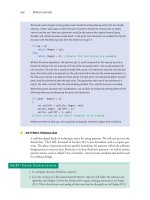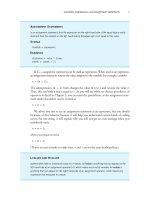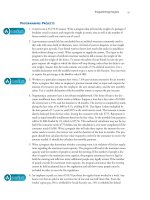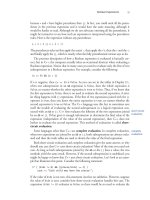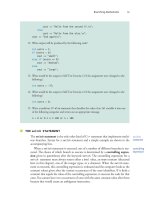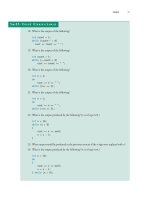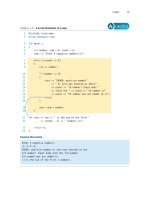Absolute C++ (4th Edition) part 20 pps
Bạn đang xem bản rút gọn của tài liệu. Xem và tải ngay bản đầy đủ của tài liệu tại đây (243.28 KB, 10 trang )
192 Arrays
Self-Test Exercises
13. Write a function definition for a function called oneMore, which has a formal parameter
for an array of integers and increases the value of each array element by 1. Add any other
formal parameters that are needed.
Display 5.4 Production Graph Program
(part 4 of 4)
S
AMPLE
D
IALOGUE
This program displays a graph showing
production for each plant in the company.
Enter production data for plant number 1
Enter number of units produced by each department.
Append a negative number to the end of the list.
2000 3000 1000 -1
Total = 6000
Enter production data for plant number 2
Enter number of units produced by each department.
Append a negative number to the end of the list.
2050 3002 1300 -1
Total = 6352
Enter production data for plant number 3
Enter number of units produced by each department.
Append a negative number to the end of the list.
5000 4020 500 4348 -1
Total = 13868
Enter production data for plant number 4
Enter number of units produced by each department.
Append a negative number to the end of the list.
2507 6050 1809 -1
Total = 10366
Units produced in thousands of units:
Plant #1 ******
Plant #2 ******
Plant #3 **************
Plant #4 **********
05_CH05.fm Page 192 Wednesday, August 13, 2003 12:51 PM
Arrays in Functions 193
14. Consider the following function definition:
void too2(int a[], int howMany)
{
for (int index = 0; index < howMany; index++)
a[index] = 2;
}
Which of the following are acceptable function calls?
int myArray[29];
too2(myArray, 29);
too2(myArray, 10);
too2(myArray, 55);
“Hey too2. Please come over here.”
int yourArray[100];
too2(yourArray, 100);
too2(myArray[3], 29);
15. Insert const before any of the following array parameters that can be changed to constant
array parameters.
void output(double a[], int size);
//Precondition: a[0] through a[size - 1] have values.
//Postcondition: a[0] through a[size - 1] have been written out.
void dropOdd(int a[], int size);
//Precondition: a[0] through a[size - 1] have values.
//Postcondition: All odd numbers in a[0] through a[size - 1]
//have been changed to 0.
16. Write a function named outOfOrder that takes as parameters an array of double and an
int parameter named size and returns a value of type int. This function will test this
array for being out of order, meaning that the array violates the following condition:
a[0] <= a[1] <= a[2] <=
The function returns -1 if the elements are not out of order; otherwise, it will return the
index of the first element of the array that is out of order. For example, consider the
declaration
double a[10] = {1.2, 2.1, 3.3, 2.5, 4.5,
7.9, 5.4, 8.7, 9.9, 1.0};
In the array above, a[2] and a[3] are the first pair out of order and a[3] is the first
element out of order, so the function returns
3. If the array were sorted, the function would
return -
1.
05_CH05.fm Page 193 Wednesday, August 13, 2003 12:51 PM
194 Arrays
Tip
Programming with Arrays
Never trust to general impressions, my boy, but concentrate
yourself upon details.
Sir Arthur Conan Doyle, A Case of Identity (Sherlock Holmes)
This section discusses partially filled arrays and gives a brief introduction to sorting and
searching of arrays. This section includes no new material about the C++ language, but
does include more practice with C++ array parameters.
■
PARTIALLY FILLED ARRAYS
Often the exact size needed for an array is not known when a program is written, or the
size may vary from one run of the program to another. One common and easy way to
handle this situation is to declare the array to be of the largest size the program could pos-
sibly need. The program is then free to use as much or as little of the array as is needed.
Partially filled arrays require some care. The program must keep track of how much
of the array is used and must not reference any indexed variable that has not been given
a value. The program in Display 5.5 illustrates this point. The program reads in a list of
golf scores and shows how much each score differs from the average. This program will
work for lists as short as one score, as long as ten scores, and of any length in between.
The scores are stored in the array
score, which has ten indexed variables, but the pro-
gram uses only as much of the array as it needs. The variable
numberUsed keeps track of
how many elements are stored in the array. The elements (that is, the scores) are stored
in positions
score[0] through score[numberUsed - 1]. The details are very similar to
what they would be if
numberUsed were the declared size of the array and the entire
array were used. In particular, the variable
numberUsed usually must be an argument to
any function that manipulates the partially filled array. Since the argument
numberUsed
(when used properly) can often ensure that the function will not reference an illegal
array index, this sometimes (but not always) eliminates the need for an argument that
gives the declared size of the array. For example, the functions
showDifference and
computeAverage use the argument numberUsed to ensure that only legal array indexes
are used. However, the function
fillArray needs to know the maximum declared size
for the array so that it does not overfill the array.
D
O
N
OT
S
KIMP
ON
F
ORMAL
P
ARAMETERS
Notice the function fillArray in Display 5.5. When fillArray is called, the declared array size
MAX_NUMBER_SCORES is given as one of the arguments, as shown in the following function call
from Display 5.5:
fillArray(score, MAX_NUMBER_SCORES, numberUsed);
5.3
05_CH05.fm Page 194 Wednesday, August 13, 2003 12:51 PM
Programming with Arrays 195
You might protest that MAX_NUMBER_SCORES is a globally defined constant and so it could be
used in the definition of
fillArray without the need to make it an argument. You would be cor-
rect, and if we did not use
fillArray in any program other than the one in Display 5.5, we could
get by without making
MAX_NUMBER_SCORES an argument to fillArray. However, fillAr-
ray
is a generally useful function that you may want to use in several different programs. We do
in fact also use the function
fillArray in the program in Display 5.6, discussed in the next sub-
section. In the program in Display 5.6 the argument for the declared array size is a different
named global constant. If we had written the global constant
MAX_NUMBER_SCORES into the
body of the function
fillArray, we would not have been able to reuse the function in the pro-
gram in Display 5.6.
Even if we used fillArray in only one program, it can still be a good idea to make the declared
array size an argument to
fillArray. Displaying the declared size of the array as an argument
reminds us that the function needs this information in a critically important way.
Display 5.5 Partially Filled Array
(part 1 of 3)
1 //Shows the difference between each of a list of golf scores and their average.
2 #include <iostream>
3 using namespace std;
4 const int MAX_NUMBER_SCORES = 10;
5 void fillArray(int a[], int size, int& numberUsed);
6 //Precondition: size is the declared size of the array a.
7 //Postcondition: numberUsed is the number of values stored in a.
8 //a[0] through a[numberUsed-1] have been filled with
9 //nonnegative integers read from the keyboard.
10 double computeAverage(const int a[], int numberUsed);
11 //Precondition: a[0] through a[numberUsed-1] have values; numberUsed > 0.
12 //Returns the average of numbers a[0] through a[numberUsed-1].
13 void showDifference(const int a[], int numberUsed);
14 //Precondition: The first numberUsed indexed variables of a have values.
15 //Postcondition: Gives screen output showing how much each of the first
16 //numberUsed elements of the array a differs from their average.
17 int main( )
18 {
19 int score[MAX_NUMBER_SCORES], numberUsed;
20 cout << "This program reads golf scores and shows\n"
21 << "how much each differs from the average.\n";
22 cout << "Enter golf scores:\n";
05_CH05.fm Page 195 Wednesday, August 13, 2003 12:51 PM
196 Arrays
Display 5.5 Partially Filled Array
(part 2 of 3)
23 fillArray(score, MAX_NUMBER_SCORES, numberUsed);
24 showDifference(score, numberUsed);
25 return 0;
26 }
27 void fillArray(int a[], int size, int& numberUsed)
28 {
29 cout << "Enter up to " << size << " nonnegative whole numbers.\n"
30 << "Mark the end of the list with a negative number.\n";
31 int next, index = 0;
32 cin >> next;
33 while ((next >= 0) && (index < size))
34 {
35 a[index] = next;
36 index++;
37 cin >> next;
38 }
39 numberUsed = index;
40 }
41 double computeAverage(const int a[], int numberUsed)
42 {
43 double total = 0;
44 for (int index = 0; index < numberUsed; index++)
45 total = total + a[index];
46 if (numberUsed > 0)
47 {
48 return (total/numberUsed);
49 }
50 else
51 {
52 cout << "ERROR: number of elements is 0 in computeAverage.\n"
53 << "computeAverage returns 0.\n";
54 return 0;
55 }
56 }
57 void showDifference(const int a[], int numberUsed)
58 {
59 double average = computeAverage(a, numberUsed);
60 cout << "Average of the " << numberUsed
61 << " scores = " << average << endl
62 << "The scores are:\n";
05_CH05.fm Page 196 Wednesday, August 13, 2003 12:51 PM
Programming with Arrays 197
Example
S
EARCHING
AN
A
RRAY
A common programming task is to search an array for a given value. For example, the array may
contain the student numbers for all students in a given course. To tell whether a particular stu-
dent is enrolled, the array is searched to see if it contains the student’s number. The simple pro-
gram in Display 5.6 fills an array and then searches the array for values specified by the user. A
real application program would be much more elaborate, but this shows all the essentials of the
sequential search algorithm. The
sequential search is the most straightforward searching
algorithm you could imagine: The program looks at the array elements in order, first to last, to see
if the target number is equal to any of the array elements.
In Display 5.6 the function
search is used to search the array. When searching an array, you
often want to know more than simply whether or not the target value is in the array. If the target
value is in the array, you often want to know the index of the indexed variable holding that
target value, since the index may serve as a guide to some additional information about the tar-
get value. Therefore, we designed the function
search to return an index giving the location of
the target value in the array, provided the target value is, in fact, in the array. If the target value
is not in the array,
search returns -1. Let’s look at the function search in a little more detail.
The function
search uses a while loop to check the array elements one after the other to see
whether any of them equals the target value. The variable
found is used as a flag to record
whether or not the target element has been found. If the target element is found in the array,
found is set to true
,
which in turn ends the while loop.
Display 5.5 Partially Filled Array
(part 3 of 3)
63 for (int index = 0; index < numberUsed; index++)
64 cout << a[index] << " differs from average by "
65 << (a[index] - average) << endl;
66 }
S
AMPLE
D
IALOGUE
This program reads golf scores and shows
how much each differs from the average.
Enter golf scores:
Enter up to 10 nonnegative whole numbers.
Mark the end of the list with a negative number.
69 74 68 -1
Average of the 3 scores = 70.3333
The scores are:
69 differs from average by -1.33333
74 differs from average by 3.66667
68 differs from average by -2.33333
sequential
search
05_CH05.fm Page 197 Wednesday, August 13, 2003 12:51 PM
198 Arrays
Display 5.6 Searching an Array
(part 1 of 2)
1 //Searches a partially filled array of nonnegative integers.
2 #include <iostream>
3 using namespace std;
4 const int DECLARED_SIZE = 20;
5 void fillArray(int a[], int size, int& numberUsed);
6 //Precondition: size is the declared size of the array a.
7 //Postcondition: numberUsed is the number of values stored in a.
8 //a[0] through a[numberUsed-1] have been filled with
9 //nonnegative integers read from the keyboard.
10 int search(const int a[], int numberUsed, int target);
11 //Precondition: numberUsed is <= the declared size of a.
12 //Also, a[0] through a[numberUsed -1] have values.
13 //Returns the first index such that a[index] == target,
14 //provided there is such an index; otherwise, returns -1.
15 int main( )
16 {
17 int arr[DECLARED_SIZE], listSize, target;
18 fillArray(arr, DECLARED_SIZE, listSize);
19 char ans;
20 int result;
21 do
22 {
23 cout << "Enter a number to search for: ";
24 cin >> target;
25 result = search(arr, listSize, target);
26 if (result == -1)
27 cout << target << " is not on the list.\n";
28 else
29 cout << target << " is stored in array position "
30 << result << endl
31 << "(Remember: The first position is 0.)\n";
32 cout << "Search again?(y/n followed by Return): ";
33 cin >> ans;
34 } while ((ans != ’n’) && (ans != ’N’));
35 cout << "End of program.\n";
36 return 0;
37 }
38 void fillArray(int a[], int size, int& numberUsed)
39 <
The rest of the definition of fillArray is given in Display 5.5
>
05_CH05.fm Page 198 Wednesday, August 13, 2003 12:51 PM
Programming with Arrays 199
Example
S
ORTING
AN
A
RRAY
One of the most widely encountered programming tasks, and certainly the most thoroughly stud-
ied, is sorting a list of values, such as a list of sales figures that must be sorted from lowest to
highest or from highest to lowest, or a list of words that must be sorted into alphabetical order.
This example describes a function called
sort that will sort a partially filled array of numbers so
that they are ordered from smallest to largest.
Display 5.6 Searching an Array
(part 2 of 2)
40 int search(const int a[], int numberUsed, int target)
41 {
42 int index = 0;
43 bool found = false;
44 while ((!found) && (index < numberUsed))
45 if (target
== a[index])
46 found = true;
47 else
48 index++;
49 if (found)
50 return index;
51 else
52 return -1;
53 }
S
AMPLE
D
IALOGUE
Enter up to 20 nonnegative whole numbers.
Mark the end of the list with a negative number.
10 20 30 40 50 60 70 80 -1
Enter a number to search for: 10
10 is stored in array position 0
(Remember: The first position is 0.)
Search again?(y/n followed by Return): y
Enter a number to search for: 40
40 is stored in array position 3
(Remember: The first position is 0.)
Search again?(y/n followed by Return): y
Enter a number to search for: 42
42 is not on the list.
Search again?(y/n followed by Return): n
End of program.
05_CH05.fm Page 199 Wednesday, August 13, 2003 12:51 PM
200 Arrays
The procedure sort has one array parameter, a. The array a will be partially filled, so there is an
additional formal parameter called
numberUsed that tells how many array positions are used.
Thus, the declaration and precondition for the function
sort are as follows:
void sort(int a[], int numberUsed);
//Precondition: numberUsed <= declared size of the array a.
//The array elements a[0] through a[numberUsed-1] have values.
The function sort rearranges the elements in array a so that after the function call is completed
the elements are sorted as follows:
a[0] ≤ a[1] ≤ a[2] ≤ ≤ a[numberUsed - 1]
The algorithm we use to do the sorting is called
selection sort
. It is one of the easiest of the sorting
algorithms to understand.
One way to design an algorithm is to rely on the definition of the problem. In this case the prob-
lem is to sort an array
a from smallest to largest. That means rearranging the values so that a[0]
is the smallest,
a[1] the next smallest, and so forth. That definition yields an outline for the
selection sort algorithm:
for (int index = 0; index < numberUsed; index++)
Place the indexth smallest element in a[index]
There are many ways to realize this general approach. The details could be developed using two
arrays and copying the elements from one array to the other in sorted order, but one array should
be both adequate and economical. Therefore, the function
sort uses only the one array contain-
ing the values to be sorted. The function
sort rearranges the values in the array a by interchang-
ing pairs of values. Let us go through a concrete example so that you can see how the algorithm
works.
Consider the array shown in Display 5.7. The algorithm will place the smallest value in
a[0]. The
smallest value is the value in
a[3], so the algorithm interchanges the values of a[0] and a[3].
The algorithm then looks for the next-smallest element. The value in
a[0] is now the smallest ele-
ment, and so the next-smallest element is the smallest of the remaining elements
a[1], a[2],
a[3]
, . . . , a[9]. In the example in Display 5.7 the next-smallest element is in a[5], so the algo-
rithm interchanges the values of
a[1] and a[5]. This positioning of the second-smallest element
is illustrated in the fourth and fifth array pictures in Display 5.7. The algorithm then positions the
third-smallest element, and so forth. As the sorting proceeds, the beginning array elements are
set equal to the correct sorted values. The sorted portion of the array grows by adding elements
one after the other from the elements in the unsorted end of the array. Notice that the algorithm
need not do anything with the value in the last indexed variable,
a[9]. Once the other elements
are positioned correctly,
a[9] must also have the correct value. After all, the correct value for
a[9] is the smallest value left to be moved, and the only value left to be moved is the value that
is already in
a[9].
The definition of the function
sort, included in a demonstration program, is given in Display 5.8.
sort uses the function indexOfSmallest to find the index of the smallest element in the
selection
sort
05_CH05.fm Page 200 Wednesday, August 13, 2003 12:51 PM
Programming with Arrays 201
unsorted end of the array, and then it does an interchange to move this next-smallest element
down into the sorted part of the array.
The function swapValues, shown in Display 5.8, is used to interchange the values of indexed
variables. For example, the following call will interchange the values of
a[0] and a[3]:
swapValues(a[0], a[3]);
The function swapValues was explained in Chapter 4.
Display 5.7 Selection Sort
a[0] a[1] a[2] a[3] a[4] a[5] a[6] a[7] a[8] a[9]
8 6 10 2 16 4 18 14 12 20
8 6 10 2 16 4 18 14 12 20
2 6 10 8 16 4 18 14 12 20
2 6 10 8 16 4 18 14 12 20
2 4 10 8 16 6 18 14 12 20
Display 5.8 Sorting an Array
(part 1 of 3)
1 //Tests the procedure sort.
2 #include <iostream>
3 using namespace std;
4 void fillArray(int a[], int size, int& numberUsed);
5 //Precondition: size is the declared size of the array a.
6 //Postcondition: numberUsed is the number of values stored in a.
7 //a[0] through a[numberUsed - 1] have been filled with
8 //nonnegative integers read from the keyboard.
9 void sort(int a[], int numberUsed);
10 //Precondition: numberUsed <= declared size of the array a.
05_CH05.fm Page 201 Wednesday, August 13, 2003 12:51 PM
